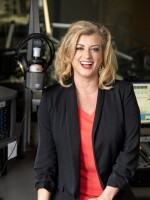It’s 7:30 a.m. in Ventura Harbor, and around 30 volunteers are boarding a boat to head to Santa Cruz Island in the Santa Barbara Channel, about 30 miles off the coast.
But this isn’t a pleasure cruise: The group is headed to the island to pick up trash and marine debris. It's part of a one-day Channel Islands clean-up.
"The Santa Barbara Channel is one of the most vibrant, ecologically important bodies of water," explained Molly Troup, Science and Program Manager for Santa Barbara Channelkeeper, a non-profit that works to protect and restore the channel and its watersheds.

This is just one of the four clean-ups they run each year.
"We see lots of different whale species and dolphins and all kinds of important animals here," Troup told KCLU.
For volunteer Lisa Werner, it’s a passion to help collect trash from beaches and protect marine life.
"I've picked up 1,471 pounds of trash. I keep track of it on my iPhone every day," said Werner. "I don't want the baby dolphins to eat this plastic, so every time I pick up just a water bottle lid, I feel like I'm keeping that out of a baby dolphin belly."
The clean-ups, funded by the NOAA Marine Debris Program, are part of a wider effort to remove debris from five different marine sanctuaries.
"These islands are part of a National Marine Sanctuary and a National Park, and nobody lives out on these islands, so it's not like just going to the beach at home and picking up trash," explained Michaela Miller. "All the trash you see is coming from the ocean, so it is really good to get a sense of how much is out there and work together."
Miller is the Acting Conservation Co-Director and Senior Conservation Manager at the National Marine Sanctuary Foundation and helps coordinate the cleanup.


The Channel Islands are especially vulnerable to marine debris, explained Justin Boevers, Marine Debris Manager for the National Marine Sanctuary Foundation.
"The way the ocean currents work, it's a lot of times it works almost like a catcher's mitt, where if anything's lost or discarded, especially fishing gear, the beaches will catch it on the different islands of the Channel Islands," added Boevers.
After about 90 minutes, we arrive at Chinese Harbor on the north side of Santa Cruz Island.
To call it a harbor is somewhat misleading. The tide is high, and the narrow stretch of coastline can be reached only by kayak or skiff.
Black trash bags and gloves are handed out, and volunteers like David Villafranca carefully navigate the unspoiled beach's pebbles, driftwood, and abalone shells.
"We're here to clean up some beaches on the Channel Islands. Hopefully, [we'll] leave the beaches a little better than we found them," said Villafrana.
The volunteers only return when their bags are full, like Werner's.
She said, "We have a Perrier bottle, a plastic water bottle, styrofoam, and an 'I love you' balloon."
Volunteer Luke Otterstedt said he found "a lot of buoys, a lot of rope, a lot of plastic water bottles, plastic tubs, like bottles of detergent, bleach, that sort of thing."
On the way back, a pod of dolphins plays in the boat's wake, as if they’re thanking this small army of volunteers. And it’s back to Ventura Harbor nine hours after we launched. The volunteers stop at Channel Islands National Park headquarters to offload dozens of black bags of trash and some larger items of debris for disposal.



